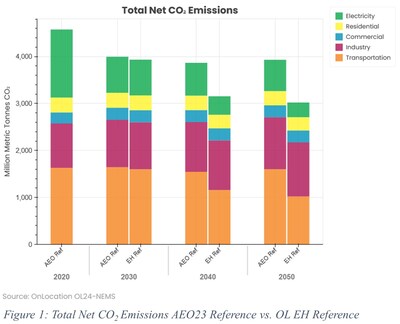VIENNA,
Va., June 26, 2024 /PRNewswire/ -- The U.S.
energy system will continue a significant transition through 2050,
driven by new technologies, policies, and consumer choices. These
will result in new market dynamics, industry challenges, and
changes in energy-related greenhouse gas emissions. OnLocation, a
KeyLogic company, produced the U.S. Energy Horizons to 2050
report to explore these issues using its enhanced version of the
National Energy Modeling System (OL-NEMS). The Horizons
report provides Reference and Advanced Technologies scenarios to
illustrate the impacts of clean technology innovation and enabling
policies that could lead to deeper decarbonization. OnLocation's
release webinar is on Thursday, June
27 at 2 p.m. (EST).

What is the OnLocation U.S. Energy Horizons to 2050
Report (OL EH)?
OL EH provides a view of the U.S. energy system through 2050 and
may be used by various stakeholders to inform policy decisions. If
specific actions are taken, it projects potential future
effects on energy supply and demand. OL EH considers the impact
of existing and potential policies and technologies affecting
energy-related greenhouse gas emissions.
OL EH is a series of modeled projections under different sets of
consistent input assumptions. Although many input assumptions
(e.g., prices, technology development, economic growth,
geopolitical developments) are uncertain long-term, OnLocation uses
the best judgment of its energy experts, informed by historical
trends and expected future changes, to develop quantitative central
pathways for model input assumptions. These central pathways
produce the OL EH Reference scenario and may be adjusted in
sensitivity scenarios to illustrate the impacts of parameter
uncertainty on the energy system.
The OL EH Reference scenario serves as a baseline against which
policy action may be compared. It assumes current laws and
regulations continue throughout the projection period, which allows
proposed policy actions or technology improvements to be modeled as
a sensitivity scenario. The impact of the OL EH Advanced
Technologies scenario is estimated by comparing scenario results
with the Reference scenario.
Why is OnLocation Releasing OL EH?
That fact that the energy system is undergoing and will continue
rapid and complex change is neither a singular nor recent
phenomenon. To assist policymaking in this dynamic environment,
the U.S. Energy Information Administration (EIA) routinely
captures the existing state of knowledge about the U.S. energy
system in its Annual Energy Outlook (AEO). Citing the need for more
time to incorporate new features to the underlying NEMS model to
reflect recent energy system changes, EIA announced they would not
release an AEO for 2024. This is the first year since the early
1980's that EIA did not produce an AEO.
OnLocation decided to produce the OL EH this year to benefit the
energy & climate modeling community. Over its 40-year history,
OnLocation has worked with EIA to build and maintain parts of NEMS,
the energy-economy model used to produce AEOs. OnLocation developed
its own version of the model, OL-NEMS, based on AEO 2023, including
new features and policy updates to address energy system issues and
CO2 mitigation strategies important to OnLocation's
clients. OL EH brings together the best of OnLocation's energy
system expertise in a modeling framework familiar to users of the
AEO.
How Did OnLocation Develop the OL EH?
OL-NEMS is based on AEO 2023. OnLocation updated this model with
publicly available data, policy updates, and new capabilities,
making OL EH markedly different from EIA's AEO 2023. OnLocation is
solely responsible for OL EH assumptions and results.
A full report will include a full list of OL-NEMS model updates
and OL EH scenario assumptions. Key updates include:
- Hydrogen production, storage, and trade (including low-carbon
hydrogen sources).
- Improved representation of carbon capture and sequestration
(CCS) and carbon markets.
- Other CO2 mitigation technologies such as direct air
capture (DAC) and sustainable aviation fuel.
- Updated regulations including new EPA greenhouse gas standards
for power plants and vehicles.
- Greater data center electricity demand growth in the commercial
sector.
- Lower cost assumptions for renewables, carbon capture, and
electric vehicles.
How Does OL EH Compare to AEO 2023?
Our key modifications lead to greater CO2 reductions in
most energy sectors by 2050 compared to AEO 2023, especially in the
power and transportation sectors, as shown in Figure 1. These
reductions are due to a more rapid phase-out of conventional fossil
fuels in favor of clean energy sources such as renewable energy and
electric vehicles in EH Ref compared to AEO.
What the EH Scenarios Reveal
While Reference scenario CO2 emissions decline over
time, net emissions in the Advanced Tech scenario are much lower
than the Reference scenario (Figure 2).
An important contributor to these reductions is that the power
sector achieves net zero CO2 by 2040 with a combination
of new renewables, battery storage, and CO2 capture
including bioenergy with carbon capture (BECCS). Some other
sectoral emissions are offset by net negative emissions from both
DAC and BECCS in industry, biofuels, and hydrogen production.
Conclusion
OL EH is accessible to organizations aiming
to explore potential future projections of the U.S. energy system
more effectively and identify strategies for influencing its
direction. Additional OnLocation reports on Data Center (AI &
Cryptocurrency) Energy Demands, Employment Impacts
of the U.S. Energy Transition, and Critical Materials Demands of
the U.S. Energy Sector are planned for later this year.
OnLocation helps public and private groups apply quantitative
tools to assess structural and regulatory challenges facing the
U.S. energy system. For more information or to book a free
consultation, please visit our website or email
contact@onlocationinc.com.
 View original content to download
multimedia:https://www.prnewswire.com/news-releases/onlocations-us-energy-horizons-to-2050-release-reference-and-advanced-technologies-scenarios-for-the-us-energy-sector-302183798.html
View original content to download
multimedia:https://www.prnewswire.com/news-releases/onlocations-us-energy-horizons-to-2050-release-reference-and-advanced-technologies-scenarios-for-the-us-energy-sector-302183798.html
SOURCE Keylogic